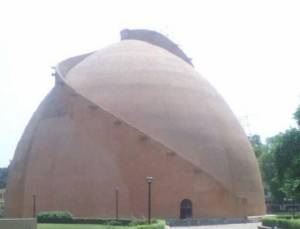Bihar – Culture And Tradition
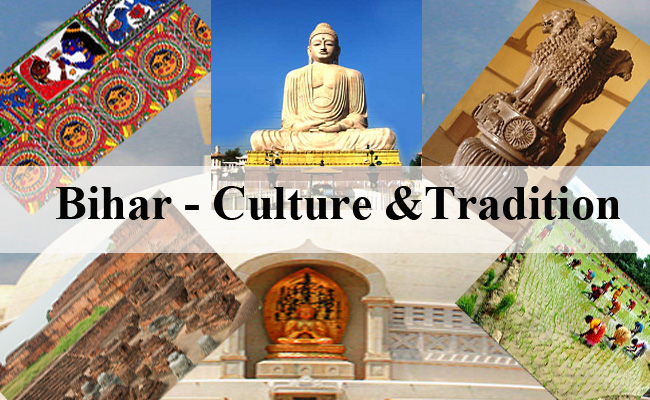
Bihar is located in the eastern part of India and is the third most populous state in the country and the 13th largest state in the area. The state is spread over an area of 695 km north of south, whereas its width from east to west is 483 km. Nepal in the north, Uttar Pradesh in the west, Jharkhand in the south, and surrounded by West Bengal in the east is a quadrilateral in the shape of Bihar.
The state enjoys a unique location-specific advantage because of its proximity to the vast markets of eastern and northern India, access to ports such as Kolkata and Haldia, and to raw material sources and mineral reserves from the neighboring states.
Bihar is one of the strongest agricultural states. Like the other states of India, about 80 percent, three-fourths of the population of the state depends on agriculture and animal husbandry, which is much higher than the national average.
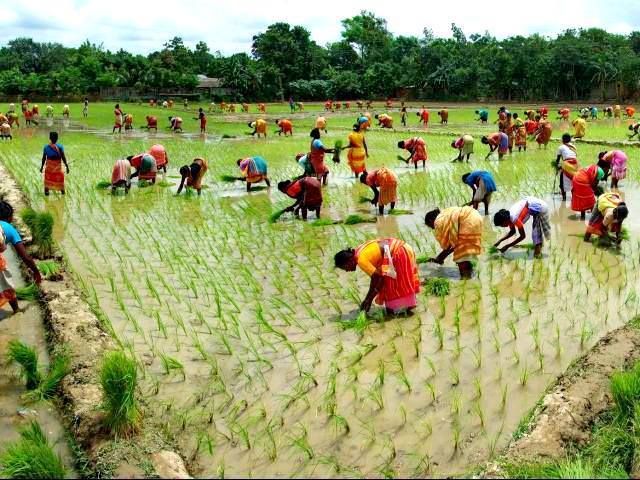
It is the fourth-largest producer of vegetables & the eighth largest producer of fruits in India. Food processing, dairy, sugar, manufacturing, and healthcare are some of the fast-growing industries in the state. The state has planned initiatives for the development of other sectors such as education and tourism and also provides incentives for information technology and renewable energy.
The state has a large base of cost-effective industrial labor, making it an ideal destination for a wide range of industries. Bihar is marked by considerable geographic, social-economical, and cultural diversity. It is endowed with a large part of the fertile Gangetic plains and well highlands rich in mineral deposits and forests.
Only 11.3 percent of Bihar’s population lives in cities, which is the lowest after Himachal Pradesh. Ancient Bihar was a very large center of education, power, and learning. Maurya and Gupta Dynasty ruled this area for a considerable time. In the ’70s, Bihar was far less economically and socially than other states of India. However, due to the government’s plans and industries, Bihar is on the path to development.
Also Read: Bihar the silk city of India
History
Bihar’s history can be traced back to the Prehistoric Period and is very ancient. The earliest history can be traced to the Hindu epic of Ramayana. Mithila was the birthplace of Lord Ram’s wife, Sita. The author of The Ramayan, Maharishi Valmiki lives in ancient Bihar.
Mahajanpada period and the rule of the Magadhan empire bring glory to ancient Bihar. Pataliputra (Patna) was the capital of ancient India’s powerful Magadha kingdom.
Bihar has experienced various invasions from different dynasties. Two of India’s most glorious dynasties, Mauryas (321 -185 BCE) and Guptas (320 to 550 CE) flourished in the ancient Bihar region which was then known as Magadh.
The Mauryan emperor, Ashoka (born c.304 BCE, died c. 232 BCE), who was born in Pataliputra (Patna) is believed to be one of the greatest rulers in the history of the world.
The Great King Ashoka of the Mauryan dynasty whose empire spread across South Asia, had his capital in Pataliputra which is present Patna. It was a prosperous center of India’s ancient civilization. Bihar has been associated with Chandragupta Maurya and Emperor Ashoka one of the greatest empires in India. There were 19 thousand Buddhist monasteries in Magadha during Emperor Ashoka.
The inscriptions of Ashok, his Dharma, and other features like the Ashoka pillar have been incorporated into the independent Republic of India. The Dharma chakra is incorporated into the national flag of India, The Indian tricolor and the figure of four lions atop a pedestal, with the inscription of a wheel, were adopted as the Official Seal of the independent Republic of India.
The great spiritual way of Buddhism originated and thrived in ancient Bihar, as Buddha attained his enlightenment in Bodhgaya. Therefore the region is full of remains of the monasteries known as Stupa. Jain leader Mahavira also belonged to this region and attained his Nirvana at Pawapuri.
In the 12th century, the invasion of Muhammad bin Khilji resulted in the Nalanda and Taxila schools destruction along with thousands of Buddhist monks.
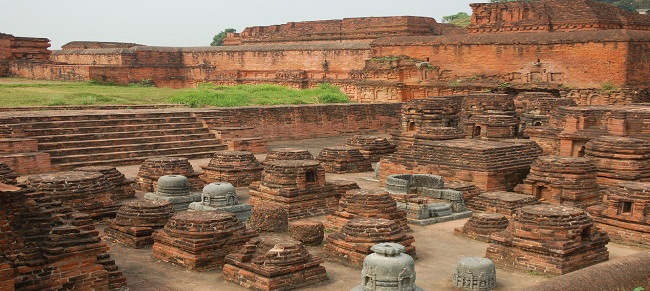
Guru Govind Singh, the tenth and last Guru of the Sikhs, was born in Patna. The Har Mandir Takht built by Maharaja Ranjit Singh to commemorate his birthplace is regarded as one of the five ‘Akal Takht’s by the Sikhs.
In medieval times, Bihar was at its peak during the reign of Sher Shah Suri who founded the city of Patna on the ancient land of Pataliputra. In the reign of the great Afghan ruler Sher Shah Suri ruled from Patna and built the Grand Trunk Road the longest road in India. Bihar saw a span of five years of good governance.
During the freedom struggle, Bihar has some greatest revolutionizers like Khudiram Bose, Prafulla Chaki, and Chandrasekhar Azad.
During British rule, Mahatma Gandhi started his first experiment of the Satyagraha movement from the Champaran region against the oppression of the indigo farmers by the Britishers. Bihar remained a part of the Bengal Presidency of British India until December 1911, when it was separated from the Bengal Presidency while Bihar and Orissa comprised a single province.
The constitution of the united Bihar and Orissa was changed to separate the state of Bihar in 1936. The present form of Bihar came into existence on 01 November 1956. In 2000, Jharkhand was made a separate state from Bihar.
Culture and Tradition

Bihar has a rich cultural heritage, it’s the land of Buddhism and Jainism. Bihar is known as “The Land of Buddha” where Gautam Buddha attained enlightenment at Bodh Gaya.
Bihar is a state with the culturally most mixed population. We have Hindus, Muslims, Jain, Buddhists, Sikhs, and Christians living here. Bihar has a rich cultural background to be proud of it is associated with ‘Samudra Manthan’ of the Vedic era, Sita of Rama, and Karna of Mahabharata. People are shy, honest, helping, and confident in themselves.
Suggested Read: Culture and Tradition of Indian States
Festivals
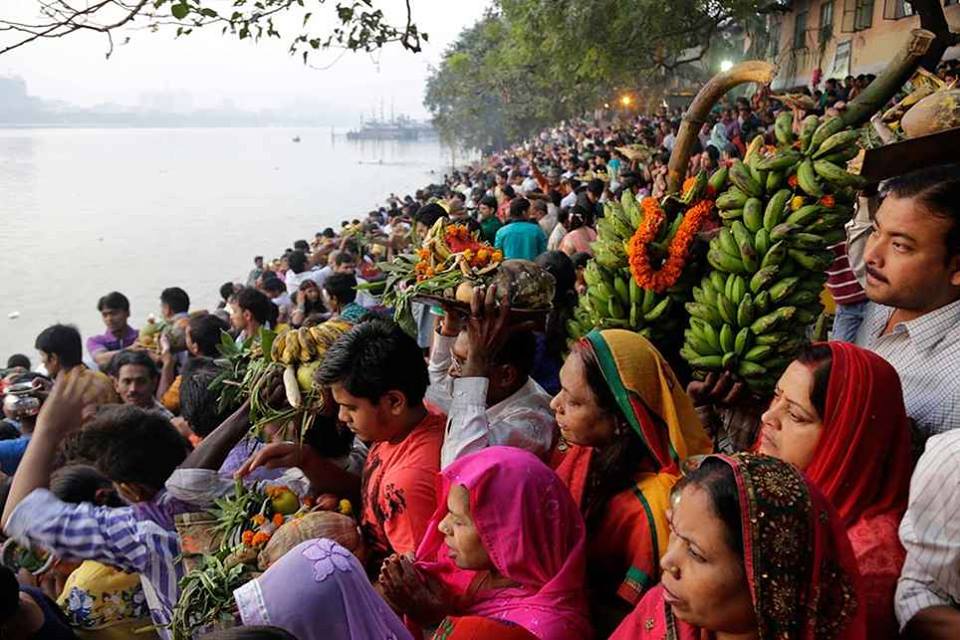
The people of Bihar celebrate festivals and religious events with great happiness and love. The main festival of Bihar is Chhath Puja, where the sun god is worshipped. While other festivals like Sama-Chakeva, Ramnavami, Makar-Sankranti, Bihula, Madhushravani, Teej, Pitrapaksha Mela, Sonepur fair, and Shravani Mela are celebrated with great enthusiasm.
Other festivals of the nation like Saraswati Puja, Holi, Ramzan, Bakrid, Mahashivaratri, Durga Puja, Diwali, Buddha Purnima, Christmas, and Mahavir Jayanti are celebrated too.
Language
In Bihar major language spoken is Hindi, while Urdu and Santali are also spoken. Hindi is the official language of the state while Maithili, Bhojpuri, Angika, and Magahi are also widely spoken in the state.
Cuisine
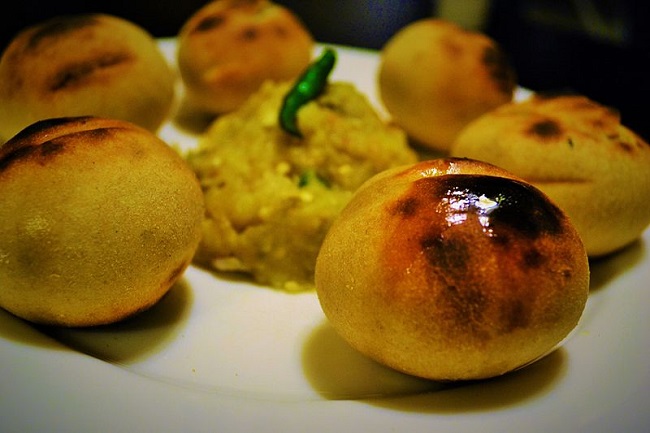
The cuisines of people of Bihar are both vegetarian and non-vegetarian. Non- vegetarianism is still less due to Buddhism and Jainism beliefs, as Buddhism and Jainism promote vegetarianism. Roti, Daal, Sabji are the basic food of Biharis.
People of Bihar are fond of eating Litti Choka, some of the popular Bihari dishes are Bihari Kebab, Litti-Chokha, Bihari Boti, Bihari Chicken Masala, Sattu Paratha, Chokha, and fish curry.
Suggested Read: Famous Food Of Indian States
Costumes
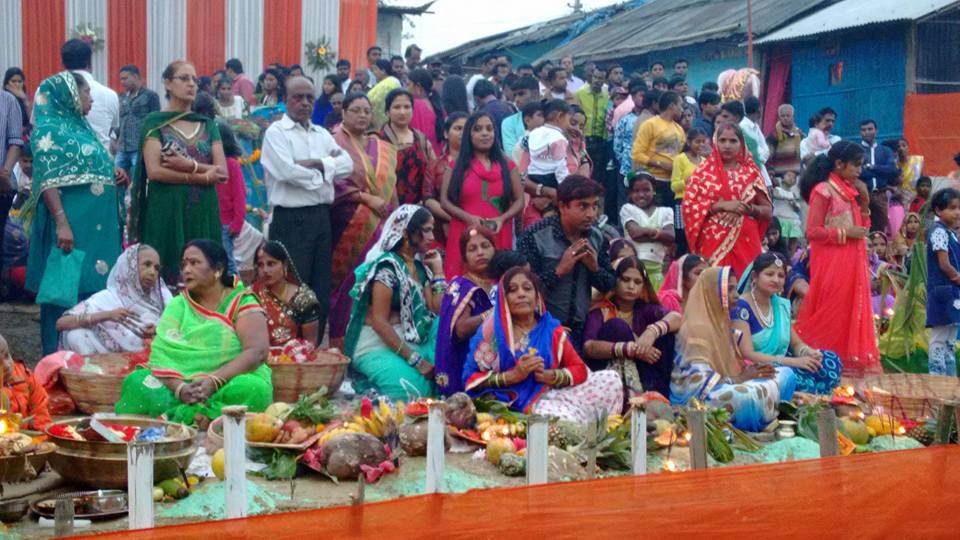
The traditional dress of the Bihari people is dhoti-kurta for men and saree for women. The effect of western wear has affected a lot of people in Bihar and people wear western shirts and trousers. Western wear is getting popular not only among urban people but also among the rural male population.
Salwar kameez is the main dress for women of urban Bihar and women wear saree in the “Seedha Aanchal” style traditionally. Tussar Silk saree is the most used in Bihari costumes.
Suggested Read: Traditional Dresses Of Indian States
Music and Dance
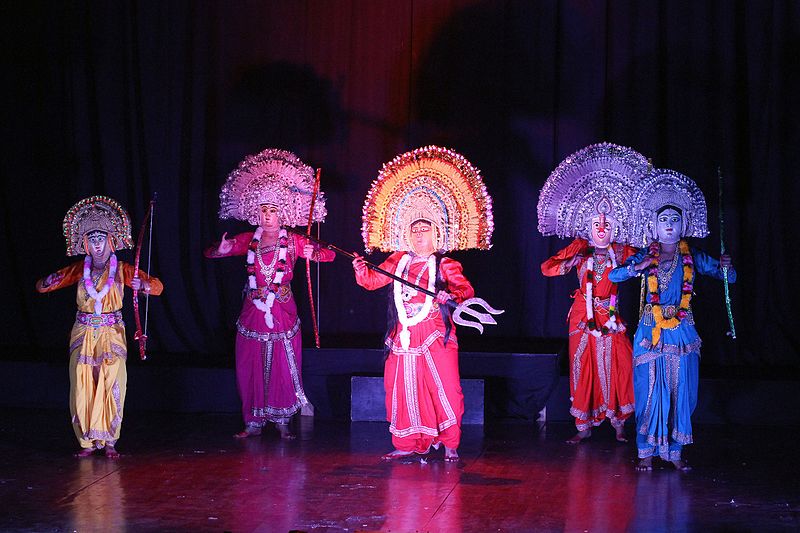
Bihar has a lot of contributions to Indian classical music. It has produced musicians like Bharat Ratna Ustad Bismillah Khan and dhrupad singers like the Malliks and the Mishras along with poets like Vidyapati Thakur who contributed to Maithili Music. Classical music in Bihar is a form of Hindustani classical music.
Chhau dance is very popular among tribal people, Bidesia is a very popular folk dance of Bihar and is more prevalent in the Bhojpuri-speaking regions of Bihar. Jat-Jatin is popular in north Bihar, Jijya is also one of the eminent dances of Bihar.
Paintings
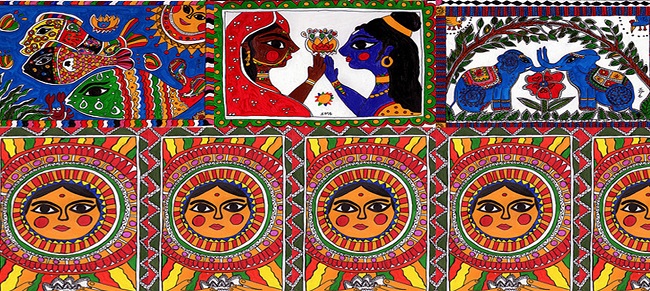
There are various traditional styles of painting that are popular in Bihar. Mithali Paintings, a style of Indian painting used in the Mithila region of Bihar also called Madhubani art. It was earlier done on mud walls but today they are done on cloth, handmade paper, and canvas. The painting is done with fingers, twigs, brushes, nib-pens, and match sticks using natural dye and mineral pigments.
Patna School of Painting called Patna Qalaam, Company Painting and was an offshoot of the well-known Mughal Miniature School of Painting flourished in Bihar from the early 18th to the mid-20th century. The style is famous for its soft colors and the use of handmade paper or mica sheets. Most of these paintings depict the life of the people of Bihar.
Crafts
Villages of Bihar create fascinating handicrafts. Fantastic bamboo articles, leather works, statues made up of white metal, wooden toys, and baskets made from cane and bamboo are available in plenty.
Bihar is famous for Sujini embroidery, Sikki Grass work, Yampuri Puppetry, Tikuli Work, Bangle making, stonework, wood inlay, Lacquerware, Pottery works, Bamboo works, and printed textile.
Tourism
Bihar’s antiquity is evident from its name, which is derived from the ancient word “VIHARA” (monastery). It is indeed a land of monasteries.
The passage of the Ganga, flowing wide and deep enrich the plains of Bihar before distributing in Bengal’s deltoid zone. There are places to visit in Buddhist, Jain, Ramayana, Sufi, Sikh, and Shiv Shakti, Bihar’s antiquity is evident from its name, abound in this ancient land where India’s first major empires rose and fell.
Among all Indian states, Bihar is the one most intimately linked to the Buddha’s life, resulting in a trail of pilgrimages that have come to be known as the Buddhist circuit.
There are places to visit for Buddhist Circuit, Jain Circuit, Ramayana Circuit, Sufi Circuit, Gandhi Circuit, Sikh Circuit, Shiv Shakti Circuit, and Eco Circuit which have many renowned places to visit. Some of the major tourist places to visit are.
Mahabodhi Temple
The holiest site for any Buddhist devotee is the Bodhi tree which stands in the middle of the Mahabodhi temple complex. About 2600 years ago Gautama Siddhartha is supposed to have realized the enlightenment at this very place under a Peepal tree known as the Mahabodhi tree.Gaya: 80’ Buddha Statue
 The Great Buddha Statue popularly known as the 80’ Buddha Statue was unveiled and consecrated on November 18, 1989, with a ceremony graced with the presence of His Holiness the XIV the Dalai Lama, who blessed the 25-meter statue
The Great Buddha Statue popularly known as the 80’ Buddha Statue was unveiled and consecrated on November 18, 1989, with a ceremony graced with the presence of His Holiness the XIV the Dalai Lama, who blessed the 25-meter statue
Vishwa Shanti Stupa
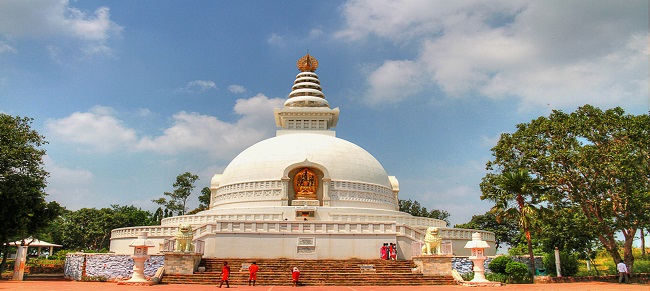
Nalanda University Ruin
It is the ruins of one of the oldest residential international universities which thrived from around the 5th or 6th century CE till the 13th century.Gol Ghar
